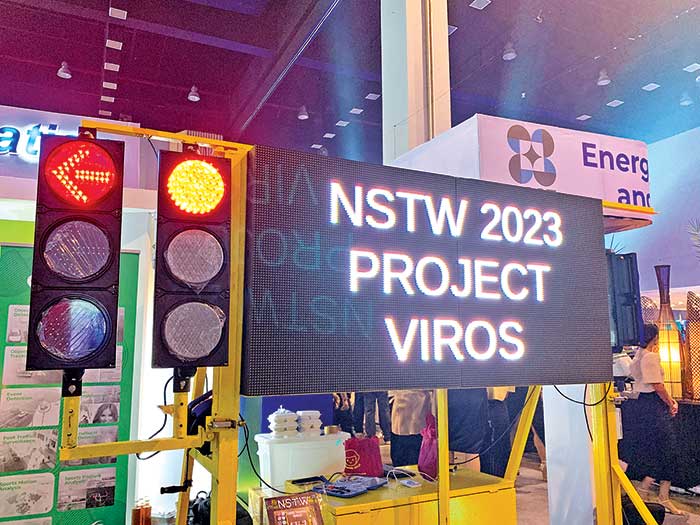
By Rjay Zuriaga Castor
Scientific innovations — some of which are powered by artificial intelligence (AI) — seeking to improve the efficiency of traffic management in the country are one of the highlights in the 2023 National Science, Technology, and Innovation Week in Iloilo City.
Funded by the Department of Science and Technology-Philippine Council for Industry, Energy and Emerging Technology Research and Development, these projects include Vehicle-to-Everything Initiatives for Road Safety (VIROS), Sustainable Technology-Assisted Route Planning for Region VI (STARPLAN-VI), Contactless Apprehension of Traffic Violators on a 24-Hour Basis and All-Vehicle Detection System (CATCH-ALL), and the software system Titan.
Daily Guardian talked to the project proponents of the scientific innovations and explored the potential of these technologies in contributing to traffic management and overall road safety.
VIROS
VIROS, a project from the University of the Philippines Diliman, aims to enhance road safety and efficiency in the Philippines through cutting-edge Vehicle-to-Everything (V2X) technology.
John Audie Cabrera, the project’s supervising senior research specialist, explained that the V2X technology proposes to design and develop an intelligent traffic controller unit with wireless communication capability.
“Vehicle-to-Everything means that vehicles can communicate with other vehicles and they can also communicate with infrastructure such as roadside units. The project is basically a push for applying an Internet-of-Things (IoT) environment for our transportation ecosystem,” he said in an interview.
Cabrera emphasized that the project is supported by AI-based methods in computer vision. The intelligent traffic controller, through these methods, can analyze traffic statistics, including vehicle recognition and vehicle flow rate, to assess the traffic condition and direct traffic.
The traffic information is then wirelessly communicated by these controllers to vehicle drivers, pedestrians, and other road users.
Cabrera highlighted that the technology has the capability to prioritize the lane of approaching emergency vehicles and even detect overspeeding through the vehicle information sent to the server.
“The intention of the project is to integrate into a more centralized system, such as in MMDA. What we did here is that these systems are modular. If there’s already an existing traffic light in an intersection, what we can do is apply the modular components, like the remote traffic controller,” he added.
STARPLAN-VI
STARPLAN-VI, a project from researchers at De La Salle University, Manila, involves the development of a bus passenger counter with a communication system for data transmission.
It includes an android application designed to track both land-based and sea-based public transport for commuters, a tool for scheduling Public Utility Vehicles (PUVs), and an infrastructure assessment tool.
Immanuel Jose Valencia said that these technologies play a vital role in supporting the planning and management of public transport.
“It is more on the fleet management of the public transportation vehicles such as buses […] We are trying to help local government units to develop yung Local Public Transport Route Plan (LPTRP),” he said.
He mentioned that the project has been deployed in public utility vehicles in Roxas City in Capiz in 2022.
Valencia said they have not yet discussed a proposal to integrate the technology into the LPTRP of Iloilo City but expressed plans to discuss it with the city government.
The city government of Iloilo is eyeing to implement its LPTRP in the first quarter of 2024.
The STARPLAN-VI also includes mobile applications developed for passengers and for drivers or operators, wherein one can have real-time bus tracking and passenger count display, route display with estimated arrival times, and optimal route suggestions, among others.
CATCH-ALL
Meanwhile, the CATCH-ALL is simply software that aims to capture traffic violators 24/7. The project was launched in May 2017.
The CATCH-ALL software application can perform work such as traffic monitoring and congestion analysis, traffic violation detection, license plate recognition, pedestrian foot traffic counts, and crowd analytics.
Valencia said the technology is an intelligent traffic management system that harnesses the power of Al and visual analytics to transform raw traffic data into valuable insights.
“Instead of deploying people to do monitoring, which is highly inefficient, in CATCH-ALL we are leveraging AI and computer vision to automate the work. One of the major outputs of CATCH-ALL is transportation analytics like in data,” said Valencia.
Among the traffic violations it can detect include number coding violations, beating the red light, and swerving.
Titan
Titan is a software system that can process videos of various traffic road scenes under different weather conditions.
“The Titan technology is about traffic monitoring, whether it is counting and classifying cars and even pedestrians. We do those counting through our technology to help policymakers draft data-driven decision-making,” said Paulo Luis Lozano.
Lozano pointed out that a significant number of video feeds remain unprocessed because of insufficient computing capacity and manpower.
He stressed that Titan is a state-of-the-art vision-based monitoring technology with the ability to categorize vehicles and pedestrians.
Apart from this, it can also generate valuable traffic-related data, including volume and density, movement speeds, and the identification of concentrations of both vehicular and human activities over extended periods.
These trailblazing innovations will be on display at the Iloilo Convention Center from November 22 to 26.




















